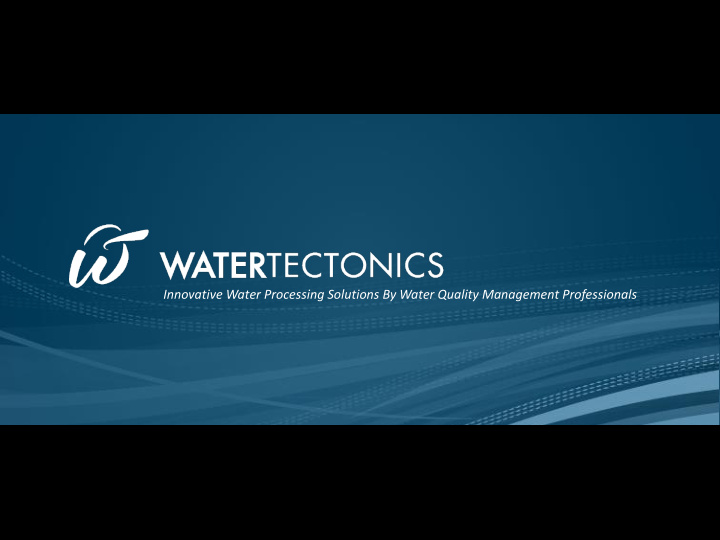



Innovative Water Processing Solutions By Water Quality Management Professionals
• Introduction to WaterTectonics • Electrocoagulation Technology • Case Studies (3 Industrial, 1 Remediation) • Conclusions
• Established in 1999 • Located in Everett, Washington • 60+ Employees • Design, manufacture, deploy, and service water treatment systems internationally • We offer a broad portfolio of technologies and services and specialize in electrocoagulation and electrochemical treatment systems • Our technologies are licensed by Fortune 500 partners and used in the natural gas industry for treating flowback water
• Electrocoagulation (or EC) is a non-chemical water treatment process • Electric current is applied across metal plates which drives metallic ions into solution • These metallic ions work as active coagulants and react with contaminants • Gas generated at the cathode assists in separating the flocculated particles (electro-flotation)
Untreated Active Coagulation Influent
Influent Post EC Post Filtration
Typical EC Target Contaminants Electrocoagulation makes particles larger… Electrocoagulation
Traditional chemical treatment Electrocoagulation drives uses counter ions to deliver zero-valent metal into solution as coagulants metallic ions FeCl 3 (aq ) ↔ Fe 3+ (aq) + 3Cl -1 (aq) Fe 0 → Fe 2+ + 2e- Al 2 (SO 4 ) 3 ↔ 2 Al 3+ + 3(SO 4 ) 2- (aq) Al 0 → Al 3+ + 3e- Electro-flotation (H 2 ) Reduced solids Free OH - help facilitate flocs No chemical handling
• The WaveIonics system is WaterTectonics’ unique approach to electrocoagulation • Packaged mobile systems from 50-1000gpm • Turnkey plant systems up to 15,000+gpm • Packaged, scalable, and high-flow designs • Automated operations with touch screen controls, web-based remote monitoring, and alert systems • Awarded GULD for construction stormwater in 2010; GULD for municipal stormwater pending
• Location: Freeland, Washington • Year Installed: 2008 • Permit: Individual NPDES • Discharge Location: Puget Sound • Site Size: 6 acres • Site Activities: Fabrication, repair, pressure washing, abrasive blasting, painting • System: 300gpm WaveIonics System + Carbon Polish
Historical Historical Permit WaveIonics Units Influent Influent Limit Effluent** Average* Maximum* Turbidity NTU - - 5 2.31 Copper, Total µg/L 109 543 5.8 2.4 Zinc, Total µg/L 641 2980 95.1 6.4 Lead, Total µg/L 12 40 14 Non-Detect Chromium, Total µg/L 11 61 50 1.9 Oil & Grease mg/L 1.7 7 5 Non-Detect *Data shown collected from Washington State Department of Ecology Fact Sheet **Data shown reflects n=4 average of 10/1/10 to 07/01/11 DMR submittal to Washington State Department of Ecology
120 100 Total Copper (µg/L) 80 Average Value = 2.7µg/L 60 On only two charges of carbon media 40 20 0 Historic 4/10 7/10 10/10 1/11 4/11 7/11 10/11 1/12 4/12 7/12 Quarter
• When dealing with low ppb level dissolved copper, determine if it is ionic or if it has formed an organo-copper complex • By removing most of the turbidity and heavy metals with the EC system, the carbon polishing system performed extremely well and was cost efficient
• Location: Kent, Washington • Year Installed: 2010 • Permit: ISWGP • Discharge Location: Spring Brook Creek • Site Size: 7.5 acres • Site Activities: Raw materials storage, truck traffic, large zinc roof contributes most of zinc • System: 300gpm WaveIonics system
800 700 Total Zinc (µg/L) 600 500 400 Average Value = 69.9µg/L 300 200 100 0 Typical 4/10 7/10 10/10 1/11 4/11 7/11 10/11 4/12 7/12 Influent Quarter
• When working with active treatment systems, treat them like cars – when they’ve been sitting around unused for awhile, give them a chance to warm up first (and make sure to change the oil!) • Fall leaves/pine needles can clog up pipes – make sure to screen them out up front of any treatment system
• Location: Whitefish, Montana • Year Installed: 2009 • Permit: MTDEQ/EPA/Coast Guard • Discharge Location: Whitefish River • Site Size: 750LF sheet-pile cofferdam isolation of affected river sediments; dewatering prior to and through 6- 48” of sediment and shoreline removal • Site Activities: Sediment Drainage, Impacted Groundwater, & Dewatering Fluids • System: 300gpm WaveIonics System
Units Influent Effluent cPAH’s/PAH’s µg/L 3,187 < 10 Mercury µg/L 8.8 < 1 Arsenic µg/L 100 < 5 Cadmium µg/L 4.1 < 1 Chromium µg/L 200 < 1 Lead µg/L 3,300 < 1
• Pilot projects can be a great way to validate technology for new applications (in this case, validating the use of EC without carbon for non- traditional contaminant removal) • Successful results from this project were looked at as a possible treatment model for Duwamish dredged sediment water treatment work
• Location: Houston, Texas • Year Installed: 2011 • Permit: TCEQ TPDES • Discharge Location: Houston Ship Channel • Site Size: 6 acres • Site Activities: Metal processing, crushing, storage • System: 400gpm WaveIonics system
Historical Historical Effluent Units Influent Permit Limit Influent Max Range Average* Copper µg/L 646 7,540 158 20 – 62.3 Lead µg/L 347 2,470 645 2 – 20.3 Zinc µg/L 1212 5,300 683 2 – 67.9 *Data shown represents average value of monthly data collected form 1/1/2002 to 11/15/2008 **Data shown provided by client on 07/30/12 from full-scale field samples
• Look at cost balance between system size vs. above-ground storage vs. below-ground storage and find the sweet spot • Other states and industries are looking to Washington and Oregon for case studies and solutions • Make sure to design systems for the right climate and weather patterns
• Technologies have come a long ways in the past four years • There are now lots of full-scale, robust, multi-year data sets out there • Still lots of exciting work going on with new applications and pilot projects • Our commitment is to continue working hard, developing better systems and driving down costs
WaterTectonics 6300 Merrill Creek Parkway Suite C-100 Everett, WA 98203 www.watertectonics.com
Recommend
More recommend